Let's be real—hauling a heavy electric scooter up a flight of stairs or onto a crowded bus is a workout no one signed up for. If you're an urban commuter, finding one of the best lightweight electric scooters isn't just a nice-to-have; it's a must. Models like the super-portable iScooter, which weighs just 26 lbs, can completely change your daily travel from a total pain into the easiest part of your day.
Why a Lightweight Scooter Is Such a Game Changer
The true beauty of a lightweight electric scooter is its portability. It’s what makes mixed-mode commuting actually work, especially in busy US and Australian cities where you need to be flexible. Think about it: you can effortlessly carry your ride onto the subway during rush hour or tuck it neatly under your desk without it becoming a trip hazard for your coworkers. This isn't just about convenience—it's about freedom.
A lighter frame means you can zip through apartment buildings, train stations, and offices without breaking a sweat. It blurs the line between riding and walking, letting you combine different travel methods on the fly. That kind of adaptability makes your daily journey faster, cheaper, and way less stressful.
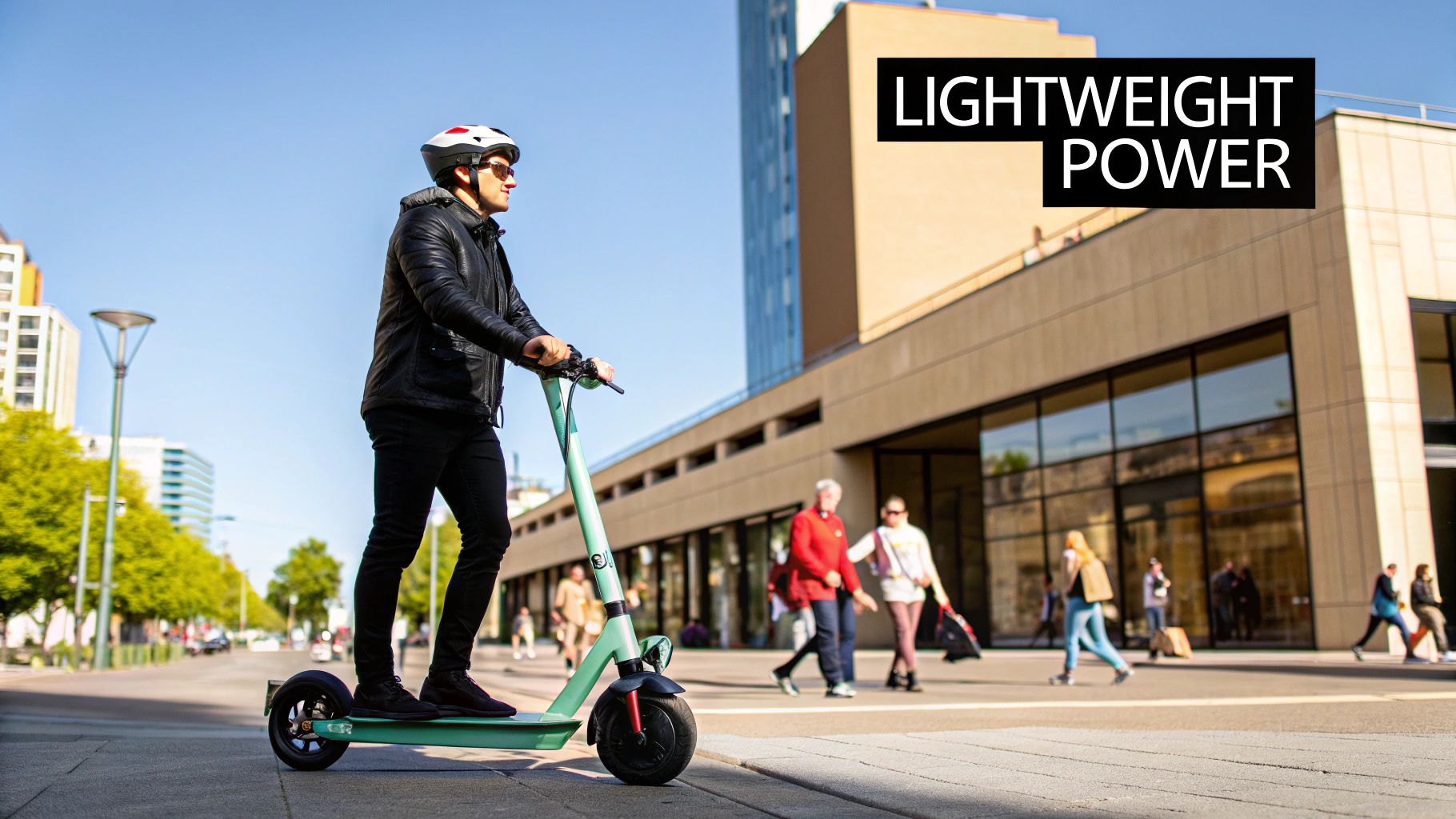
The Urban Commuting Advantage
For anyone living in a city, space is a premium. A heavy, clunky scooter can take over a small apartment's hallway or clutter up your workspace. A lightweight model, on the other hand, comes with some serious perks:
- Effortless Storage: You can stash it discreetly in a closet, slide it under a bed, or pop it in the trunk of a car. It's built for modern living.
- The Perfect Last-Mile Solution: It perfectly closes that gap between the train station or bus stop and your front door, turning a boring walk into a quick, fun ride.
- Spontaneous Trips: Feel like meeting friends across town after work? A portable scooter is always good to go, without the logistical nightmare a heavier machine can create.
This growing need for portable, eco-friendly transport is obvious when you look at the market. The global electric scooter market is on track to hit USD 91.1 billion by 2035, growing at a rate of 9.1% each year. This tells us there's a major shift toward compact city transport that fits our busy lives. You can read the full research about electric scooter market growth to see the whole picture.
The Bottom Line: The biggest plus of a lightweight electric scooter isn't just the low number on the scale; it's the incredible flexibility it adds to your lifestyle. It gives you the power to get around complex urban environments with total ease.
How Portability Plays Out in Real Life
Let's look at how a lightweight model actually compares to a heavier one in a few everyday situations.
| Scenario | Heavy Scooter (20kg+) | Lightweight Scooter (Under 15kg) |
|---|---|---|
| Living in a Walk-Up | A serious physical challenge. You'll need some muscle every single time. | Easy to carry with one hand, making the climb no big deal. |
| Taking Public Transport | A nightmare. It's bulky and often not even allowed during peak hours. | Folds down small and can be carried on board without any fuss. |
| At the Office | A pain to store. You'll likely have to leave it in an insecure spot or trip over it all day. | Tucks away neatly under a desk or in a locker. Out of sight, out of mind. |
At the end of the day, choosing one of the best lightweight electric scooters is an investment in a smoother, more connected travel experience. It’s all about making your city more accessible, one portable ride at a time.
How to Judge a Lightweight Electric Scooter
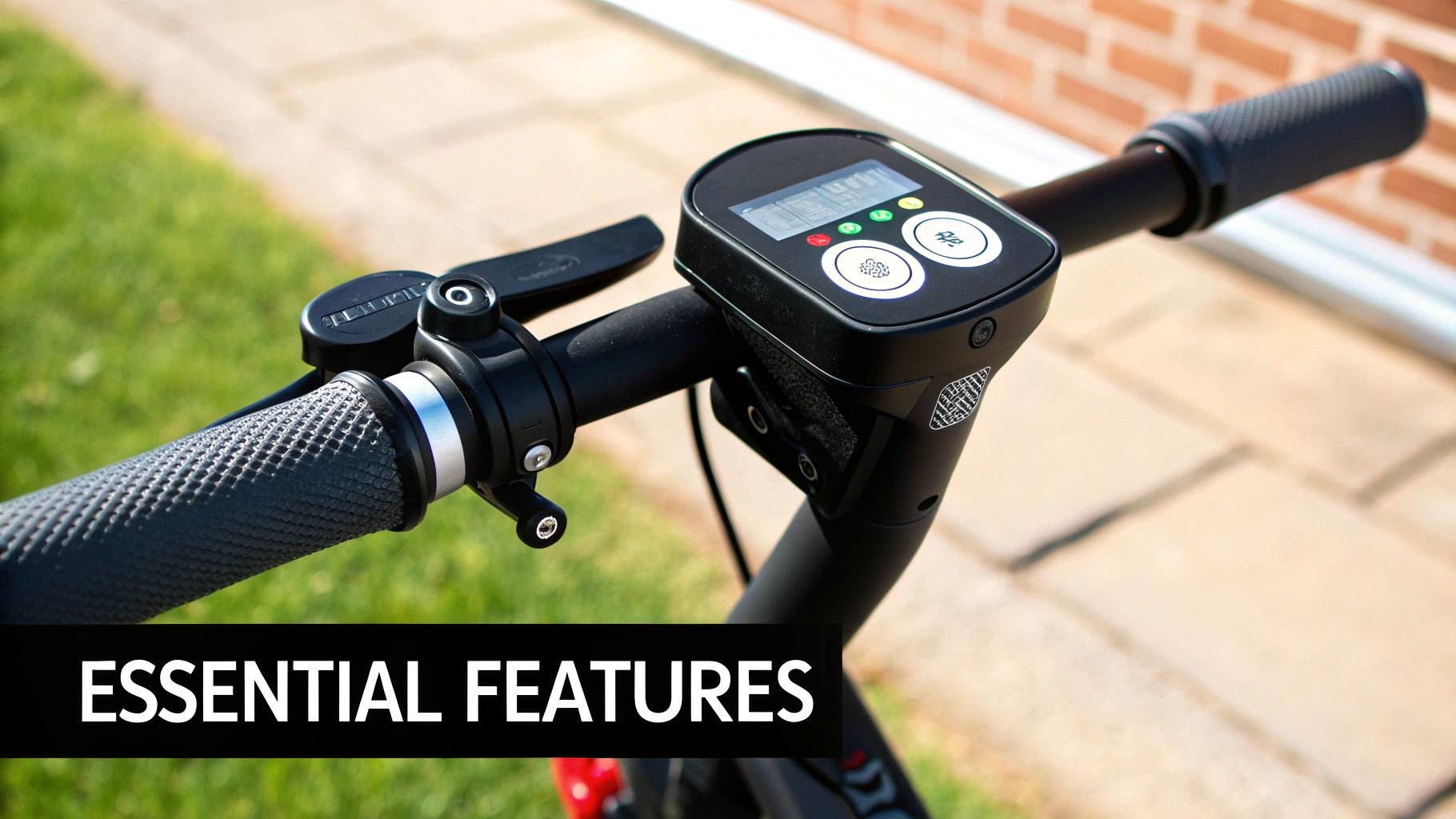
Before you jump in and add a scooter to your cart, let’s talk about what actually makes a lightweight model good. It’s not just about finding the lowest number on the scale. It's about spotting the smart engineering and understanding the crucial trade-offs that separate the best from the rest.
Picking a great lightweight scooter is all about striking the right balance. Every gram shaved off has to come from somewhere, and that usually means making clever compromises on things like the battery, motor, and frame. Getting this balance right is the secret to finding a scooter that perfectly fits how you’ll actually use it.
The Weight vs. Range Trade-Off
Let's get one thing straight: the heaviest part of any electric scooter is its battery. This creates a simple, direct trade-off. A bigger battery gives you more range, but it also means more weight to lug up a flight of stairs.
The top-tier brands use advanced, high-density lithium-ion cells to cram more juice into a smaller, lighter pack. Even so, you’ll see that the super-light models—anything under 12 kg (26 lbs)—typically give you a real-world range of around 10-15 miles. If you step up to a "heavier" lightweight model in the 13-15 kg (28-33 lbs) bracket, you might see that range climb closer to 20-25 miles.
Key Insight: Stop looking at the max advertised range. Think about your daily commute. If you only travel 3 miles each way, a nimble scooter with a 12-mile range is a much smarter buy than a heavier one with a 25-mile range you’ll never actually use.
Be honest with yourself about your daily journey. Paying for (and carrying) extra range you don't need is a classic rookie mistake.
Motor Power and Real-World Performance
It’s easy to get distracted by a motor’s peak power, but for zipping around cities in the US or Australia, the nominal (or continuous) power is what really matters. That figure tells you how much power the motor can consistently deliver without getting too hot and bothered.
For mostly flat city routes, a motor with 250W to 350W of nominal power is plenty. It’ll get you up to speed quickly and handle gentle slopes without a problem. But if your daily grind includes steep hills, like the ones in San Francisco or Sydney, you’ll want to look for a model with at least a 350W nominal output, if not more.
- Peak Power: Great for a quick burst of acceleration off the line.
- Nominal Power: A much better indicator of how it'll handle sustained climbs and its overall muscle.
Some clever scooters, like the Inmotion Climber, even use dual motors to deliver serious hill-climbing power without piling on the pounds. It's a smart way to get portable performance. If you really want to get into the weeds on the tech specs, our guide to help you compare electric scooter models breaks it all down.
Build Quality and Essential Features
A lightweight frame still needs to be tough enough to handle daily abuse. Always look for scooters built from high-quality materials that give you a fantastic strength-to-weight ratio.
- Aircraft-Grade Aluminum: This is the industry standard for good reason. It’s strong, light, and won't rust.
- Carbon Fiber: This is the premium stuff. It’s incredibly light and ridiculously strong, but it’ll cost you.
- Magnesium Alloy: Often found in high-end models, it's even lighter than aluminum but just as tough.
Beyond the frame itself, don't forget about safety and comfort. A solid braking system is non-negotiable—ideally, you want a combination of a disc brake and an electronic brake. And for the often-uneven city sidewalks, even a little bit of suspension or some bigger pneumatic tires can make a world of difference to your ride.
Finally, make sure any scooter you’re considering has bright, built-in front and rear lights. You'll need them for those early morning commutes and late-night rides.
The Best Lightweight Electric Scooters Compared
Alright, let's get down to the nitty-gritty. You know the specs to look for, but how do the top lightweight scooters actually stack up against each other? We're going to dive into a real-world, head-to-head comparison of the best models you can get your hands on in the US and Australia.
A scooter that's perfect for a student zipping across a flat campus will probably struggle on the hilly commute of a city professional. My goal here is to highlight the quirks and standout features of each model to help you find the one that genuinely fits your daily life, not just the one that looks best on a spec sheet.
This chart gives you a quick visual on the trade-offs you'll be making between weight, range, and price with some of the most common types of lightweight scooters.
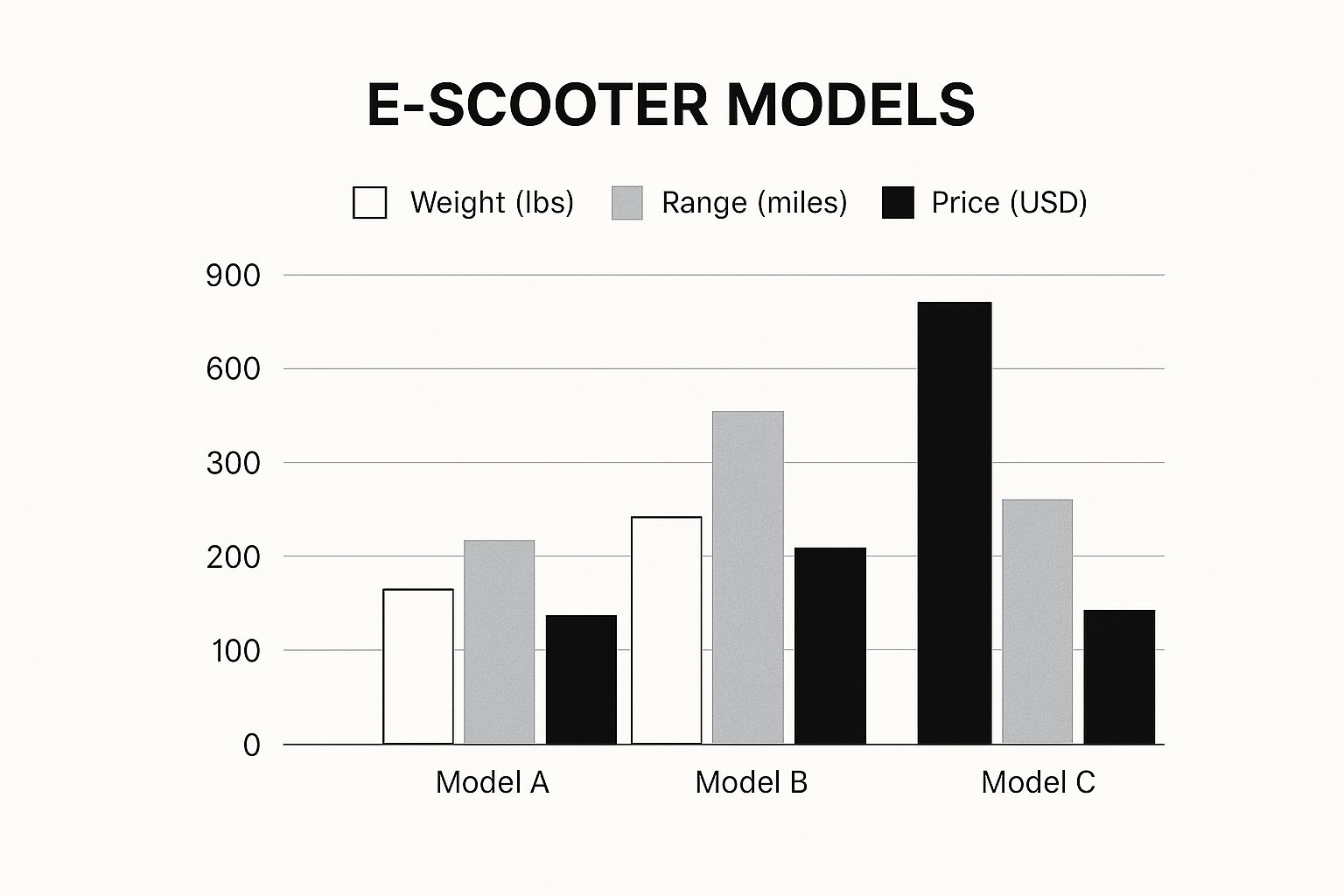
As you can see, the lightest models are easier on the wallet but won't take you as far. If you want more mileage, you'll have to accept a bit more weight and a higher price tag.
Lightweight Electric Scooter Showdown
To make things even clearer, here's a direct comparison of our top picks. This table lays out the key performance metrics side-by-side, so you can see exactly where each scooter shines.
| Model | Weight (lbs) | Max Range (miles) | Top Speed (mph) | Price (USD) | Best For |
|---|---|---|---|---|---|
| iScooter | 26 | 18 | 15.5 | ~$300 | Ultimate Portability |
| Niu KQi3 Max | 46.3 | 40 | 23.6 | ~$899 | All-Round Daily Commuting |
| Inmotion Climber | 46 | 35 | 23.6 | ~$999 | Conquering Steep Hills |
While the numbers tell part of the story, the real difference is in how these scooters feel to ride and live with every day. Let's break down who each one is for.
For the Ultimate Urban Minimalist: The iScooter
If your main goal is to find a scooter you can tuck under your arm without a second thought, the iScooter should be at the top of your list. Tipping the scales at a mere 26 lbs (11.8 kg), it’s one of the most portable options out there. It's an absolute dream for anyone whose commute involves jumping on and off trains or buses.
The whole design is built around one idea: maximum portability. It's a sleek, no-fuss machine that's perfect for closing that "last mile" gap from the station to the office. The folding mechanism is a breeze, letting you collapse it in seconds.
But, this laser focus on low weight means making some sacrifices. The 350W motor is peppy enough for flat city streets, but you'll feel it struggling on anything more than a gentle slope. And while the box might say 18 miles of range, you'll get less than that in real-world conditions, so it's best for shorter trips.
Key Takeaway: The iScooter is the perfect tool for short, flat commutes with multiple stops. Its featherlight build makes it incredibly easy to carry, but don't expect it to be a long-distance cruiser or a hill-climbing beast.
For the All-Round Commuter: The Niu KQi3 Max
Moving up a bit in weight, the Niu KQi3 Max offers a much more balanced ride for the average commuter. At around 46.3 lbs (21 kg), it's still manageable to carry up a flight of stairs, but that extra heft gives you a major boost in performance and comfort that most people will appreciate.
The real difference-maker is its beefy 450W motor. It has the torque you need to confidently tackle the hills you find in most American or Australian cities. This isn't just about getting up inclines; it makes the whole ride feel more responsive and secure, especially in stop-and-go traffic.
That larger frame also houses a bigger battery, pushing its realistic range to a solid 25-30 miles on one charge. This means you can handle a longer commute or go for a weekend cruise without constantly worrying about finding a plug.
- Wider Handlebars: Gives you much better steering control and stability, especially at higher speeds.
- Larger Deck: More room for your feet means a more comfortable stance on longer journeys.
- Pneumatic Tyres: These air-filled tires are a lifesaver, soaking up the bumps from notoriously uneven pavements far better than solid tires.
All this makes the Niu KQi3 Max a fantastic all-rounder. It hits that sweet spot between being portable enough and having the power and range for a more demanding daily commute.
For the Hill-Conquering Explorer: The Inmotion Climber
What if your daily route includes hills that would make other scooters weep? That's where a specialist like the Inmotion Climber steps in. It's at the heavier end of the "lightweight" spectrum at 46 lbs (20.8 kg), but its unique dual-motor setup is in a league of its own.
The Climber has two 750W motors—one in each wheel. This all-wheel-drive system delivers incredible traction and raw power, capable of eating up gradients as steep as 36%. If you live in a hilly city, this isn't just a cool feature; it's essential.
Expert Insight: "The Inmotion Climber is a game-changer for anyone who has to deal with hills on a regular basis. The dual 750W motors handle steep inclines without feeling like a challenge, offering power to tackle whatever terrain you throw at it."
All that power doesn't kill the battery, either. The Climber can still hit an impressive 35 miles on a single charge, making it great for both brutal commutes and weekend adventures. The only real trade-off is its weight. It's noticeably heavier to lug around than the iScooter, so it's not the best choice if you have to carry it often.
Ultimately, picking between these fantastic scooters comes down to being honest about your needs. Think about your daily route, how often you'll need to carry it, and your budget. That's how you'll find the scooter that truly fits into your life.
How Scooters Got So Light and Smart
Ever picked up one of the latest lightweight electric scooters and wondered how they pack so much punch into such a tiny frame? It’s not magic. It's a fascinating blend of smart engineering and cutting-edge materials that are completely changing the game for personal transport.
It all starts with the battery. This is, by far, the heaviest single component in any e-scooter, so any progress here makes a huge difference. Engineers have been working overtime to cram more power into smaller, lighter lithium-ion cells. The result is a battery pack that can shrink in size without totally sacrificing your daily range, giving us those featherlight designs we all want.
Stronger Than They Look Materials
But a lighter battery doesn't mean much if the frame is still a chunk of heavy steel. To really drop the weight, manufacturers have moved on to advanced alloys and composites. This is where the most dramatic weight savings come from, creating a body that’s tough as nails but still easy to tuck under your arm.
- Carbon Fiber: This stuff used to be just for supercars and pro-level racing bikes. Now, it's making its way into top-of-the-line e-scooters. The strength-to-weight ratio is just incredible, making for a frame that's both ridiculously light and stiff.
- Magnesium Alloys: Even lighter than the aircraft-grade aluminum you see everywhere, magnesium alloys offer comparable strength. This material is the secret sauce in many of the best ultralight models, helping to shave off those last few critical pounds.
These materials aren’t just about weight, either. A stiffer, better-built frame gives you much more responsive handling and a solid, connected feel on the pavement. It makes the whole ride safer and, frankly, a lot more fun.
The Bottom Line: Creating the perfect lightweight scooter is a careful balancing act. It's the clever combination of high-density batteries and space-age frame materials that lets designers cut weight without sacrificing the strength and safety you need for a confident ride.
The Brains Behind the Brawn
It’s not just about the hardware anymore; the software inside the scooter is making a massive difference. Modern e-scooters are loaded with smart features that enhance everything from performance to the user experience.
These aren't just flashy gimmicks—they offer real, practical benefits. For example, a sophisticated Battery Management System (BMS) acts as the battery's bodyguard, using smart algorithms to monitor its health, manage power, and seriously extend its lifespan. That means you get a more reliable scooter for years to come.
App connectivity is pretty much standard now, too. It lets you become the master of your ride, tweaking acceleration, capping your top speed, or dialing in the regenerative braking right from your phone. The integration of smarter tech, like AI, is pushing things even further with features like predictive maintenance alerts and advanced safety systems. This kind of tech is a huge part of what makes the best lightweight electric scooters so impressive. You can see for yourself how AI is shaping the scooter market and get a glimpse into the future of getting around town.
Which Lightweight Scooter Fits Your Life
It's one thing to read a list of specs, but how does that translate to your actual day-to-day? The best lightweight electric scooter isn't just about numbers on a page; it’s the one that effortlessly becomes a part of your routine.
Let's walk through a few common scenarios. This will help you see past the marketing and pinpoint the perfect ride for how you actually get around. Being honest about what you need a scooter for is the first step. A scooter that’s a dream for quick, multi-stop trips might be a total headache for someone who lives for long weekend cruises. It's all about matching the machine to the mission.
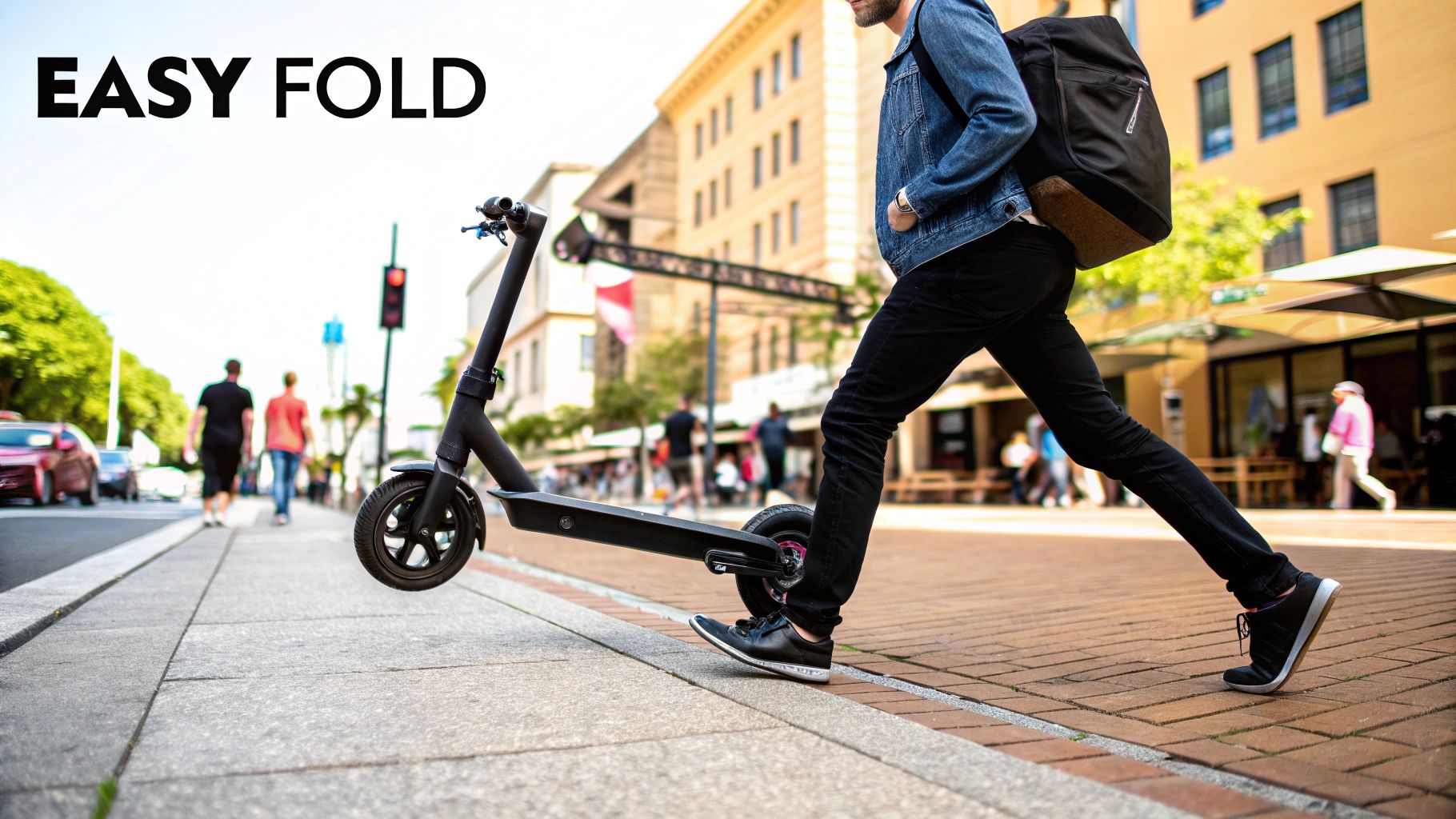
The Last-Mile Commuter
Does this sound familiar? You ride to the train station, hop on public transport, and then scooter the final stretch to your office. If you're living that mixed-mode commute life, then one word should be at the top of your list: portability.
Your ideal ride is going to be incredibly light, probably tipping the scales at under 28 lbs (about 13 kg). Even more crucial is a dead-simple, lightning-fast folding mechanism. You’ll be carrying this thing up stairs and through crowds, so you need to be able to fold it in seconds without a fight.
Here’s what to zero in on:
- Weight: Go for the absolute lowest you can find without getting something that feels flimsy.
- Folding Speed: A one-click system is non-negotiable. You don't have time to mess with clunky latches during rush hour.
- Compact Size: Once folded, it needs to be small enough to tuck under a train seat or beside your desk without being a tripping hazard.
Honestly, top speed and massive range take a backseat here. A real-world range of 10-12 miles is almost always plenty for those first and last legs of your trip.
The Urban Explorer
Maybe your scooter isn't about the daily grind. It's your ticket to weekend freedom—zipping across town to meet friends, discovering new neighborhoods, or just enjoying a long, breezy ride along the river. Your priorities are a bit different.
You still want something easy to handle, but you can afford a few extra pounds in exchange for a much better ride. A slightly heavier frame, maybe in the 30-40 lbs range, usually means a bigger battery and a more powerful motor. Trust me, you'll be glad you have them on longer journeys.
For the Urban Explorer, it’s a game of endurance and ride quality. Sacrificing a little bit of 'carry-ability' for a lot more range and comfort is a trade-off that pays off big time on a day-long adventure.
Look for a scooter with a solid balance of these features:
- Extended Range: Aim for something that can realistically give you 20 miles or more on a charge.
- Comfort Features: Pneumatic (air-filled) tires or even a basic suspension system make a world of difference on bumpy city streets. A wider deck for more foot room is a huge plus, too.
- Sufficient Power: A motor with at least 350W of nominal power will get you up the occasional hill without slowing to a crawl.
This is the kind of scooter that helps you reclaim your city on your own terms.
The Campus Navigator
For students, the perfect scooter is a mix of tough, portable, and affordable. You need to get from your dorm to a lecture hall on the other side of campus—fast. But it also has to survive being locked up outside, getting bumped around, and daily use.
Weight matters when you have to haul it into a library or up a flight of stairs, but ruggedness is just as critical. You’re not just buying a ride; you’re buying a reliable tool for your academic life. The ideal campus scooter is simple, tough, and not so pricey that a few scratches feel like the end of the world.
A great starting point is our comprehensive electric scooter buying guide, which really dives into the core components to look for.
Here’s what students should keep in mind:
- Durability: Look for a solid frame, simple mechanics, and scooters with a reputation for holding up.
- Security: Make sure there's an obvious and secure spot to loop a heavy-duty lock through.
- Affordability: You need a solid performer that fits a student-friendly budget.
Once you figure out which of these riders you are, you can stop getting lost in spec sheets and start thinking about how a scooter will actually make your life better. That’s the real secret to finding the perfect one.
Got Questions About Lightweight Scooters? We've Got Answers.
Choosing the right scooter means getting into the nitty-gritty. It’s totally normal to have a few questions rattling around even after reading a bunch of reviews. We've been there.
So, let's tackle some of the most common things people ask when they're hunting for that perfect lightweight ride. Consider this your final checklist before you pull the trigger.
Can a Lightweight Scooter Actually Handle Hills?
This is a big one, and the honest answer is... maybe. It really comes down to the motor. You'll see a lot of talk about "peak power," but the number you really need to care about is the nominal power (or sustained wattage). To shave off weight, many of these ultra-light models have to make a compromise here.
If you live somewhere with actual hills, you’ll want a scooter with at least 350W of nominal motor power. Anything less than that, and you’re going to feel it chugging and slowing to a crawl on anything more than a gentle slope.
Expert Take: Don't just trust the spec sheet. The best thing you can do is hunt down user reviews or YouTube videos showing the scooter tackling a real-world incline with a real person on it. That’s where you’ll see the truth.
How Long Does a Lightweight Scooter Battery Really Last?
We're not talking about range here, but the battery's overall lifespan. Most modern scooter batteries are good for 500 to 1,000 charge cycles. For someone who rides their scooter to work and back, that typically works out to about two to four years of solid performance before you start noticing the range isn't what it used to be.
But you have a lot of control over this. How you treat your battery has a massive impact on its longevity. A few simple habits can make a world of difference:
- Don't run it to zero: Try to plug it in before it drops below 20%. Constantly draining it completely puts a lot of stress on the cells.
- Stick with the original charger: It's designed to deliver the exact voltage your battery needs. Don't use a knock-off.
- Keep it at room temp: Extreme cold or heat is a battery killer. Avoid storing your scooter in a freezing garage or a hot car trunk.
Think of it like this: a little bit of care goes a long way in protecting your investment and keeping your scooter zippy for years.
How Do Lightweight Scooters Stand Up to Local Weather?
Whether it's a sudden downpour in Florida or a chilly morning in Melbourne, weather is a factor. Most decent e-scooters have an IP rating, which tells you how well they handle dust and water. A common one you'll see is IP54.
An IP54 rating means the scooter can handle splashes from any direction. So, if you get caught in a light drizzle on your way home, you're probably fine. But—and this is a big but—it is not waterproof. Riding through deep puddles or in a proper downpour is asking for trouble, and water damage is almost never covered by the warranty.
Cold is the other factor. When the temperature plummets, your battery's range can temporarily drop by as much as 20-30%. It’s just chemistry. The best way to deal with this is to store and charge your scooter inside where it’s warm.
And while we're talking about protecting your scooter, don't forget about theft. We've put together some solid, practical advice on how to lock an electric scooter the right way.
Here at Punk Ride, our whole mission is to match you with a ride that just fits. Whether you need something you can carry onto a train or a zippy little explorer for weekend fun, we’ve hand-picked the best of the best. Find your next ride and change the way you move through your city by visiting us at https://www.punkride.com.




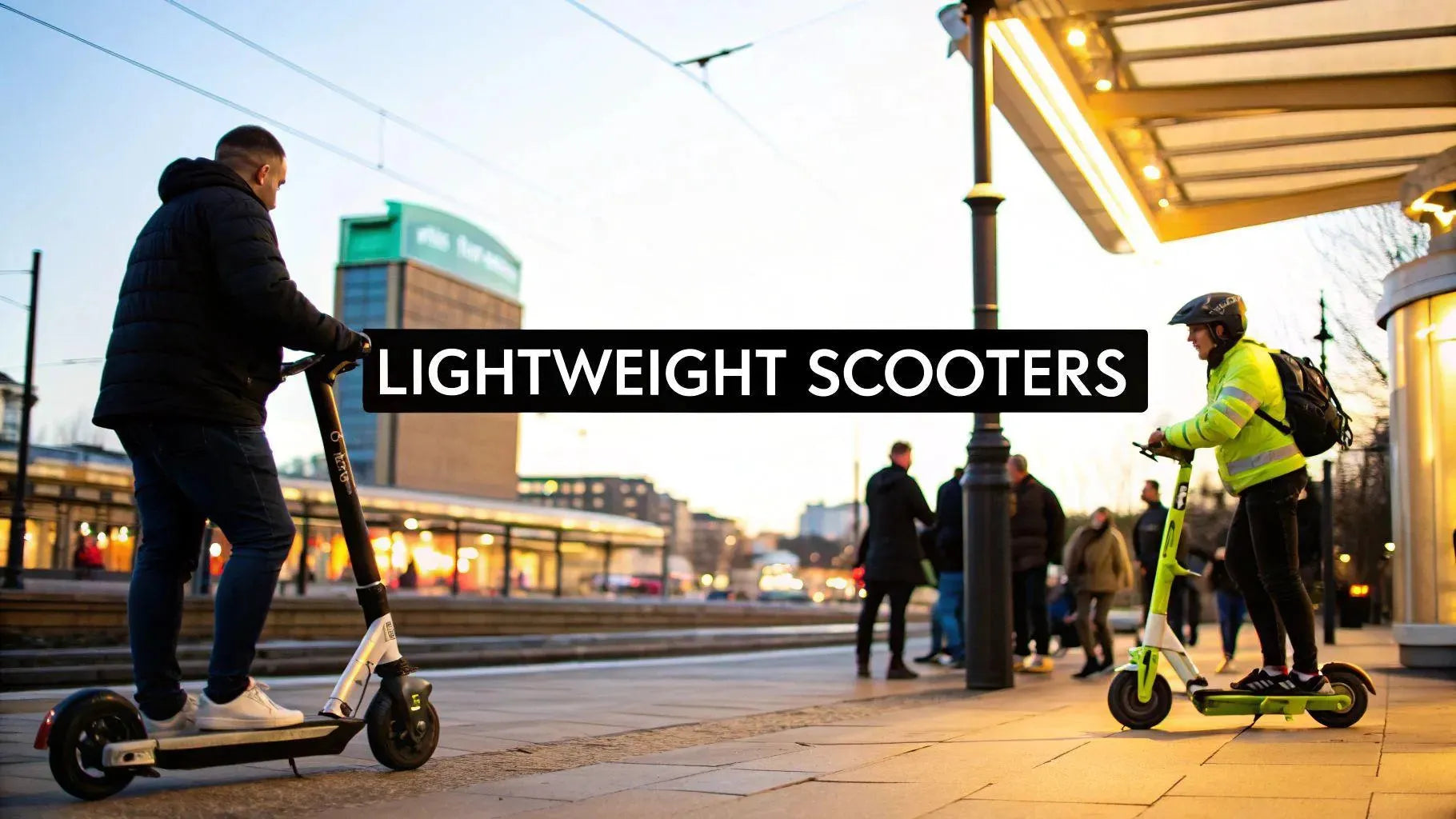
Share:
Best Electric Scooters For Adults
Top Picks: Best Electric Bikes for Hills in 2024